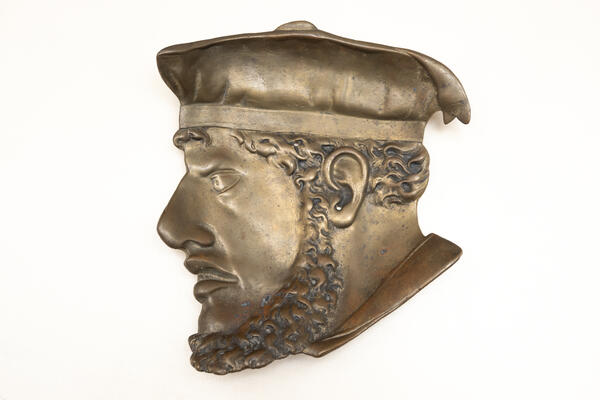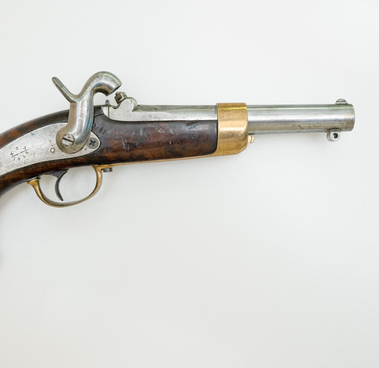The ashtray from the museum collection, made in the 19th century, belonged to the Vice Admiral Pyotr Ivanovich Baranovsky. In 1853-1855, during the Crimean War, he was the commander of the battleship “Empress Maria.”
The ashtray is made of light bronze. It is shaped like a male profile of a French navy sailor.
Pyotr Baranovsky was born in Sevastopol. In 1824, he was enlisted in the Black Sea Fleet with the rank of midshipman. In 1828–1829, as a midshipman, Baranovsky took part in the Russian-Turkish war, and later in the hostilities in the Mediterranean Sea.
In 1838, for the bravery shown in battles, Pyotr Baranovsky received the Order of St. Stanislas, 3rd class. In the 1840s, he became the commander of the transport ship “Gagra”, and then the ship “Rion”, which transported goods between the Black Sea ports.
In the 1840s — early 1850s, Baranovsky commanded the military ships “Argonaut” and “Flora”, received the rank of captain of the 2nd rank, by virtue of long service — the Order of St. George 4th class and St. Anna 3rd class.
On the 84-gun ship “Empress Maria” Baranovsky in 1853 transported soldiers and officers of the Belostok regiment of the 13th division from Sevastopol to Sukhum-Kale (a large city of Abkhazia). And on November 18 of the same year, under the flag of Admiral Pavel Nakhimov, he took part in the Battle of Sinop. The battle was named after the place of the battle: it took place in the harbor of the Turkish city of Sinop, 300 kilometers from Sevastopol. The Russian sailing fleet defeated the enemy in a few hours. Baranovsky was wounded and shell-shocked. On November 28, 1853, he was awarded the grade of captain of the 1st rank for military service.
During the defense of Sevastopol, Baranovsky commanded the same ship and the 40th naval crew, as well as a battery on the North Side. He was awarded the Order of St. Stanislas, 2nd class with swords. Pyotr Baranovsky retired in 1885 with the rank of vice-admiral.
After the death of the vice-admiral, the ashtray was kept in the family by his two granddaughters: Inna and Olga Baranovsky. In 1945-1947, they lived in Yevpatoria, in a communal apartment with Vera Kozyrkina, to whom they bequeathed the family relic.
The ashtray is made of light bronze. It is shaped like a male profile of a French navy sailor.
Pyotr Baranovsky was born in Sevastopol. In 1824, he was enlisted in the Black Sea Fleet with the rank of midshipman. In 1828–1829, as a midshipman, Baranovsky took part in the Russian-Turkish war, and later in the hostilities in the Mediterranean Sea.
In 1838, for the bravery shown in battles, Pyotr Baranovsky received the Order of St. Stanislas, 3rd class. In the 1840s, he became the commander of the transport ship “Gagra”, and then the ship “Rion”, which transported goods between the Black Sea ports.
In the 1840s — early 1850s, Baranovsky commanded the military ships “Argonaut” and “Flora”, received the rank of captain of the 2nd rank, by virtue of long service — the Order of St. George 4th class and St. Anna 3rd class.
On the 84-gun ship “Empress Maria” Baranovsky in 1853 transported soldiers and officers of the Belostok regiment of the 13th division from Sevastopol to Sukhum-Kale (a large city of Abkhazia). And on November 18 of the same year, under the flag of Admiral Pavel Nakhimov, he took part in the Battle of Sinop. The battle was named after the place of the battle: it took place in the harbor of the Turkish city of Sinop, 300 kilometers from Sevastopol. The Russian sailing fleet defeated the enemy in a few hours. Baranovsky was wounded and shell-shocked. On November 28, 1853, he was awarded the grade of captain of the 1st rank for military service.
During the defense of Sevastopol, Baranovsky commanded the same ship and the 40th naval crew, as well as a battery on the North Side. He was awarded the Order of St. Stanislas, 2nd class with swords. Pyotr Baranovsky retired in 1885 with the rank of vice-admiral.
After the death of the vice-admiral, the ashtray was kept in the family by his two granddaughters: Inna and Olga Baranovsky. In 1945-1947, they lived in Yevpatoria, in a communal apartment with Vera Kozyrkina, to whom they bequeathed the family relic.



